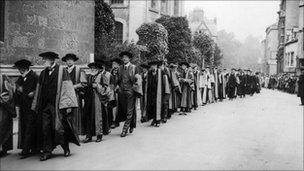Universities Superannuation Scheme
- Published

The scheme is the seventh largest in the UK's public sector
Some very big changes to the scheme are being introduced from the start of October 2011. The details are below. Meanwhile, the current benefits apply.
How many employees does the scheme cover?
Staff of more than 400 participating employers such as universities, higher education institutions and other associated institutions.
However the scheme is not within the scope of Lord Hutton's review of public service pension schemes.
How many sections are there?
Until 1 October 2011 there is just one, final-salary, section. At that point a career average scheme will be brought in for new joiners.
How many members are there?
As of 31 March 2010, there were 137,932 active members, 83,201 deferred members, 46,060 pensioners, and 9,572 beneficiaries.
What are the principal benefits?
The scheme provides a pension linked to final-salary.
There is an 1/80th accrual rate per year, providing a possible pension of half final-salary, plus a 3/80ths lump sum.
The normal pension age is 65 but early retirement for some is possible at 60 with no reduction for early payment.
How much is paid in?
Employers pay in 16% of staff salaries and members pay in 6.35%.

Staff at more than 400 institutions are in the scheme
What is the funding cost of the scheme?
22.5% of salaries need to be paid in.
Is the scheme funded or unfunded?
Funded. The benefits are paid for by an underlying investment fund.
Is it in deficit or surplus?
At the last valuation, as of 31 March 2008, the fund had a surplus of £707m, or 103% of liabilities.
What is the value of scheme's assets, if any, and liabilities?
At the last actuarial valuation the scheme had assets of £28.8bn.
What is the average pension in payment?
£17,329 a year.
Have there been any changes or reforms in recent years?
No.
Are any changes in the pipeline?
Yes. The scheme will change considerably from 1 October 2011.

Academics as they used to be: Oxford dons in 1922
These changes are independent of those the government is trying to introduce in other public service schemes but are similar in some respects.
The USS changes are:
1) A normal pension age of 65 will come in for new entrants and for the future service of many existing members. The exceptions to this will be those members who are in the scheme before 1 October - and who are also aged 55 or over at that date. They will be exempt from the normal reductions in their accrued pensions that will be imposed if they take their pensions before the age of 65.
2) The normal USS pension age will rise in line with any increases in the state pension age, which is scheduled to rise to 66 by 2020. It is important to note that this will only affect pension built up after April 2020.
3) The employee contribution rate for members of the final-salary section will increase from 6.35% to 7.5% from 1 October 2011.
4) Pension increases (for pensions in payment and deferred pensions) will be inflation-proofed in line with increases in the consumer prices index (CPI) up to 5% a year. But for pensions earned after 1 October 2011, if inflation is more than 5% but less than 15% the increase in pension will be 5% plus half of the increase above that level. And if inflation is more than 15% there will be no extra pension increases - they will be capped at 10% a year.
5) A career-average revalued earnings (CARE) benefits structure will be implemented for new entrants. The benefits will still be based upon a 1/80th accrual rate and cash lump sum of three times the pension.
6) The contribution rate for members of the new CARE section will be 6.5%.
7) If the overall cost of the scheme rises above 23.5% of salaries then cost sharing will be introduced. This means any further increases in contributions will be shared in the ratio 65:35 between employers and employees respectively.
Source: Universities Superannuation Scheme.